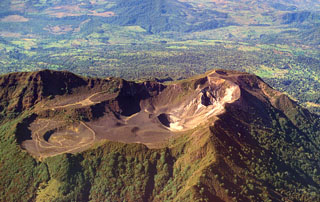Report on Turrialba (Costa Rica) — 25 May-31 May 2016
Smithsonian Institution / US Geological Survey
Weekly Volcanic Activity Report, 25 May-31 May 2016
Managing Editor: Sally Sennert.
Please cite this report as:
Global Volcanism Program, 2016. Report on Turrialba (Costa Rica) (Sennert, S, ed.). Weekly Volcanic Activity Report, 25 May-31 May 2016. Smithsonian Institution and US Geological Survey.
Turrialba
Costa Rica
10.025°N, 83.767°W; summit elev. 3340 m
All times are local (unless otherwise noted)
OVSICORI-UNA reported that a strong explosion detected at Turrialba at 2145 on 24 May generated ash plumes that rose 3.5 km above the volcano and drifted SW. The event ejected large rocks around the crater. About one hour later ashfall was reported in multiple areas, including Santa Rosa de Oreamuno, Santa Cecilia de Heredia, and San Francisco de Heredia. At 0015 on 25 May tremor amplitude increased, and at 0030 explosions ejected abundant amounts of ash and incandescent rocks. At 0812 a gas-and-ash plume rose 500 m above the active craters. Large amounts of ash (deposits 2-7 mm thick) fell in the several neighborhoods in the towns of Carthage, Heredia (38 km W), San José (70 km W), and Alajuela (49 km W). Tremor was continuous throughout the day but the amplitude had decreased by 1900. Ash emissions continued, with plumes rising 500 m above the volcano. Tremor decreased at around 0200 on 27 May; emissions likely did not contain ash, which was confirmed at dawn. Ashfall and a strong sulfur odor was reported by residents of Aquiares (11 km SSE), Santa Cruz de Turrialba (8 km SSE), and central Turrialba. Seismicity remained low during 28-31 May, and gas emissions from the crater persisted.
Geological Summary. Turrialba, the easternmost of Costa Rica's Holocene volcanoes, is a large vegetated basaltic-to-dacitic stratovolcano located across a broad saddle NE of Irazú volcano overlooking the city of Cartago. The massive edifice covers an area of 500 km2. Three well-defined craters occur at the upper SW end of a broad 800 x 2200 m summit depression that is breached to the NE. Most activity originated from the summit vent complex, but two pyroclastic cones are located on the SW flank. Five major explosive eruptions have occurred during the past 3500 years. A series of explosive eruptions during the 19th century were sometimes accompanied by pyroclastic flows. Fumarolic activity continues at the central and SW summit craters.
Source: Observatorio Vulcanologico y Sismologico de Costa Rica-Universidad Nacional (OVSICORI-UNA)

